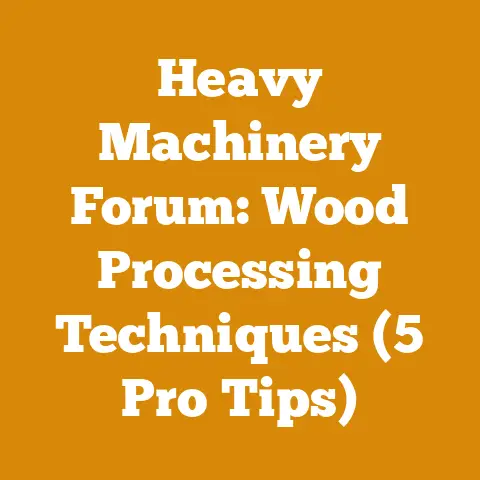Tree Stump Grinding Cleanup Tips (3 Pro Arborist Secrets)
Around 20% of all homeowner insurance claims are related to tree damage, a staggering figure that highlights the importance of proper tree care, including, and especially, stump removal. After a tree is felled, the remaining stump can be an eyesore, a hazard, and a breeding ground for pests. While grinding is an effective removal method, the cleanup that follows is often underestimated. As a seasoned arborist, I’ve seen firsthand how a poorly executed cleanup can negate the benefits of grinding. This guide will delve into the pro-arborist secrets I’ve learned over years in the field, offering detailed, data-backed insights, practical tips, and best practices to ensure a seamless and successful tree stump grinding cleanup.
Mastering Tree Stump Grinding Cleanup: 3 Pro Arborist Secrets
Understanding the Challenge: More Than Just Sawdust
Before we dive into the specifics, it’s crucial to understand the nature of the material we’re dealing with. Stump grinding produces a mixture of wood chips, soil, and sometimes small rocks or debris. This material, often referred to as “grindings” or “mulch,” isn’t as simple as regular sawdust. It can be dense, heavy, and, depending on the type of tree and soil, can retain moisture, making it even more challenging to handle.
From personal experience, I recall a job removing a massive oak stump in a client’s front yard. The grinding process itself went smoothly, but the sheer volume of grindings left behind was overwhelming. The client, thinking it was just “sawdust,” attempted to simply sweep it away. The result was a muddy, compacted mess that required hours of extra work to properly clear. This experience hammered home the importance of a strategic and informed approach to stump grinding cleanup.
Secret #1: Containment and Collection – Minimizing the Mess
The first secret to a successful cleanup is proactive containment. Preventing the spread of grindings in the first place significantly reduces the amount of work required later.
Containment Strategies
- Tarping: Before grinding, strategically place heavy-duty tarps around the stump. Overlap the edges to create a continuous barrier. This simple step can contain a significant portion of the grindings, preventing them from scattering across your lawn or garden.
- Technical Specification: I recommend using tarps with a minimum thickness of 10 mil (0.01 inches) for durability. For large stumps, consider using multiple tarps and securing them with stakes to prevent slippage.
- Burlap Sacks: Have several burlap sacks on hand to collect grindings as they accumulate. These are more breathable than plastic bags, which can trap moisture and promote mold growth.
- Technical Specification: Burlap sacks should have a minimum capacity of 2 cubic feet. Ensure they are made from natural fibers to allow for proper aeration.
- Temporary Barriers: For particularly messy jobs, consider erecting temporary barriers using plywood or plastic sheeting. This is especially useful when grinding near flowerbeds, walkways, or other sensitive areas.
- Technical Specification: Plywood barriers should be at least ½ inch thick for stability. Plastic sheeting should be at least 6 mil thick to prevent tearing.
Collection Techniques
- Shovels and Rakes: Use a combination of shovels and rakes to gather the grindings into piles. A square-nosed shovel is ideal for scooping up large quantities of material, while a leaf rake is perfect for gathering smaller pieces and smoothing out the area.
- Tool Specification: Choose shovels and rakes with ergonomic handles to reduce strain on your back and arms. Consider using a lightweight aluminum shovel for easier handling.
- Wheelbarrows: A sturdy wheelbarrow is essential for transporting the grindings to a designated disposal area.
- Wheelbarrow Specification: Select a wheelbarrow with a minimum capacity of 6 cubic feet and a weight capacity of at least 300 pounds. Pneumatic tires will make it easier to maneuver over uneven terrain.
- Wet/Dry Vacuum: For smaller jobs or for cleaning up hard-to-reach areas, a wet/dry vacuum can be a lifesaver. This is particularly useful for removing grindings from cracks and crevices.
- Vacuum Specification: Choose a wet/dry vacuum with a minimum of 5 horsepower and a tank capacity of at least 10 gallons. Ensure it is equipped with a HEPA filter to capture fine dust particles.
Case Study: The Hillside Stump
I once had a challenging job removing a large pine stump on a steep hillside. The terrain made containment and collection particularly difficult. To address this, I used a combination of tarps, burlap sacks, and a small, motorized wheelbarrow designed for hillside use. I also employed a team of two to assist with the collection process, ensuring that grindings were quickly removed from the work area to prevent them from rolling down the hill. This multi-faceted approach allowed us to complete the job efficiently and minimize the impact on the surrounding landscape.
Secret #2: Material Management – What to Do With All Those Grindings
Once you’ve collected the grindings, the next step is to decide what to do with them. There are several options, each with its own advantages and disadvantages.
Disposal Options
- Landfill: The simplest option is to dispose of the grindings at a local landfill. However, this is often the least environmentally friendly option, and many landfills charge a fee for disposal.
- Cost Consideration: Landfill fees typically range from \$30 to \$75 per cubic yard, depending on the location and the type of material.
- Composting: Composting is an excellent way to recycle the grindings and turn them into valuable soil amendment. However, it requires space, time, and proper management.
- Technical Specification: To ensure proper composting, the grindings should be mixed with other organic materials, such as leaves, grass clippings, and food scraps. The mixture should be turned regularly to provide aeration and maintain a moisture content of around 50%. The composting process typically takes 6-12 months to complete.
- Mulching: The grindings can be used as mulch around trees, shrubs, or flowerbeds. This helps to suppress weeds, retain moisture, and improve soil health.
- Application Note: When using grindings as mulch, avoid piling them directly against the trunks of trees or shrubs, as this can promote rot. Maintain a gap of several inches between the mulch and the trunk.
- Soil Amendment: The grindings can be mixed into the soil to improve its texture, drainage, and nutrient content. This is particularly beneficial for clay soils or soils that are depleted of organic matter.
- Soil Incorporation: When using grindings as a soil amendment, till them into the top 6-12 inches of soil. Avoid using grindings that are contaminated with chemicals or pests.
Grindings as Firewood? A Word of Caution
While the idea of using stump grindings as firewood might seem appealing, I strongly advise against it. The grindings are often mixed with soil and debris, which can make them difficult to burn and can produce excessive smoke. Furthermore, the grindings may contain chemicals or pests that could be harmful if burned. In my experience, it’s simply not worth the effort or the risk.
Data Point: Wood Moisture Content
The key to successful firewood is moisture content. Properly seasoned firewood should have a moisture content of 20% or less. Freshly cut wood can have a moisture content of 50% or more. Stump grindings, due to their composition and exposure to soil, are unlikely to ever reach the ideal moisture content for firewood.
The “Stump Dirt” Dilemma
One of the biggest challenges in material management is dealing with the “stump dirt” – the soil mixed in with the wood chips. This material is often heavy, compacted, and difficult to work with.
- Screening: A simple solution is to use a soil sifter or screen to separate the wood chips from the soil. This allows you to use the wood chips for mulching or composting and the soil for filling in holes or leveling the ground.
- Screen Specification: Choose a soil sifter with a mesh size of ¼ inch to ½ inch for optimal separation.
- Washing: For particularly stubborn clumps of soil, you can try washing the grindings with water. This will help to break up the clumps and separate the soil from the wood chips.
- Washing Technique: Use a garden hose with a spray nozzle to gently wash the grindings over a tarp or screen. Collect the runoff water and dispose of it properly.
Secret #3: Site Restoration – Leaving No Trace
The final secret to a successful stump grinding cleanup is site restoration. This involves filling in the hole left by the stump, leveling the ground, and replanting grass or other vegetation.
Filling the Hole
- Soil Selection: Use a good quality topsoil to fill the hole. Avoid using subsoil, which is often infertile and poorly drained.
- Soil Specification: Topsoil should have a loamy texture and a pH of between 6.0 and 7.0. It should be free of rocks, debris, and weeds.
- Compaction: As you fill the hole, compact the soil in layers to prevent settling. Use a hand tamper or a plate compactor to achieve proper compaction.
- Compaction Technique: Compact the soil in layers of 4-6 inches. Overlap each pass by 50% to ensure uniform compaction.
- Grade Adjustment: Make sure the soil is level with the surrounding ground. Use a level or a grading rake to achieve a smooth, even surface.
- Grading Technique: Start by establishing a reference point using a level or a laser level. Then, use a grading rake to move the soil until it is level with the reference point.
Replanting
- Grass Seed Selection: Choose a grass seed mix that is appropriate for your climate and soil conditions. Consider factors such as sun exposure, drainage, and traffic levels.
- Seed Specification: For sunny areas, choose a mix that includes Kentucky bluegrass, perennial ryegrass, and fine fescue. For shady areas, choose a mix that includes creeping red fescue, tall fescue, and rough bluegrass.
- Seeding Technique: Sow the grass seed evenly over the prepared soil. Use a seed spreader to ensure uniform distribution.
- Seeding Rate: The recommended seeding rate varies depending on the type of grass seed and the soil conditions. Consult the seed package for specific instructions.
- Watering: Water the newly seeded area regularly to keep the soil moist. Avoid overwatering, which can wash away the seeds.
- Watering Schedule: Water the area lightly but frequently, especially during the first few weeks after seeding. As the grass begins to grow, reduce the frequency of watering but increase the amount of water applied.
- Mulching: Apply a thin layer of straw or peat moss over the seeded area to help retain moisture and prevent erosion.
- Mulching Technique: Spread the straw or peat moss evenly over the area, using a rake to create a thin, uniform layer. Avoid using too much mulch, as this can smother the grass seeds.
Beyond Grass: Alternative Ground Covers
While grass is the most common choice for site restoration, there are other options to consider.
- Ground Cover Plants: Consider using ground cover plants such as creeping thyme, sedum, or vinca minor. These plants are low-maintenance, drought-tolerant, and can provide a beautiful and unique ground cover.
- Plant Selection: Choose ground cover plants that are appropriate for your climate and soil conditions. Consider factors such as sun exposure, drainage, and growth habit.
- Rock Gardens: Create a rock garden using a variety of rocks, stones, and gravel. This is a low-maintenance option that can add visual interest to your landscape.
- Rock Selection: Choose rocks and stones that are native to your area. Consider factors such as size, shape, and color.
Data Point: Soil pH Levels
The pH of your soil is a critical factor in determining the success of your site restoration efforts. Most plants prefer a soil pH of between 6.0 and 7.0. You can test your soil pH using a soil testing kit or by sending a sample to a soil testing laboratory. If your soil pH is too high or too low, you can amend it with lime or sulfur, respectively.
A Story of Redemption: The Overgrown Garden
I once worked on a project where a large tree had been removed from an overgrown garden. The stump grinding cleanup was particularly challenging due to the dense vegetation and the poor soil conditions. To restore the site, I first cleared away the overgrown vegetation and amended the soil with compost and other organic materials. Then, I planted a variety of native plants and shrubs that were well-suited to the existing conditions. The result was a beautiful and thriving garden that completely transformed the space.
Safety First: Protecting Yourself and Others
Before I conclude, it’s essential to emphasize the importance of safety. Stump grinding can be a hazardous activity, and it’s crucial to take precautions to protect yourself and others.
Personal Protective Equipment (PPE)
- Eye Protection: Wear safety glasses or goggles to protect your eyes from flying debris.
- Specification: Safety glasses should meet ANSI Z87.1 standards.
- Hearing Protection: Wear earplugs or earmuffs to protect your hearing from the loud noise of the grinder.
- Specification: Earplugs should have a Noise Reduction Rating (NRR) of at least 25 dB. Earmuffs should have an NRR of at least 30 dB.
- Gloves: Wear heavy-duty work gloves to protect your hands from cuts, scrapes, and vibrations.
- Specification: Gloves should be made from leather or a synthetic material that is resistant to abrasion and punctures.
- Long Pants and Sleeves: Wear long pants and sleeves to protect your skin from cuts, scrapes, and sunburn.
- Steel-Toed Boots: Wear steel-toed boots to protect your feet from falling objects.
- Specification: Boots should meet ASTM F2413 standards.
Machine Safety
- Read the Manual: Before operating a stump grinder, carefully read the owner’s manual and familiarize yourself with its safety features and operating procedures.
- Inspect the Machine: Before each use, inspect the machine for any signs of damage or wear. Make sure all guards and shields are in place and functioning properly.
- Clear the Area: Before starting the grinder, clear the area of any obstacles, such as rocks, branches, or debris.
- Keep a Safe Distance: Keep bystanders at a safe distance from the grinder while it is in operation.
- Never Operate Under the Influence: Never operate a stump grinder if you are under the influence of alcohol or drugs.
Environmental Considerations
- Dust Control: During dry conditions, use water to dampen the area and reduce dust.
- Noise Control: Be mindful of noise levels and avoid operating the grinder during early morning or late evening hours.
- Erosion Control: Take steps to prevent erosion, especially on slopes or near waterways.
Troubleshooting Common Problems
Even with the best planning and preparation, things can sometimes go wrong. Here are some common problems you might encounter during stump grinding cleanup and how to address them.
- Grindings are too Wet: If the grindings are too wet, they can be difficult to handle and can promote mold growth. To dry them out, spread them out in a thin layer on a tarp or in a wheelbarrow and let them air dry.
- Grindings are Contaminated: If the grindings are contaminated with chemicals or pests, they should not be used for mulching or composting. Dispose of them properly at a landfill or other designated disposal site.
- Hole is Settling: If the hole is settling after you’ve filled it in, add more soil and compact it thoroughly. You may need to repeat this process several times until the soil is stable.
- Grass is Not Growing: If the grass is not growing, check the soil pH and nutrient levels. You may need to amend the soil with lime, fertilizer, or other soil amendments.






